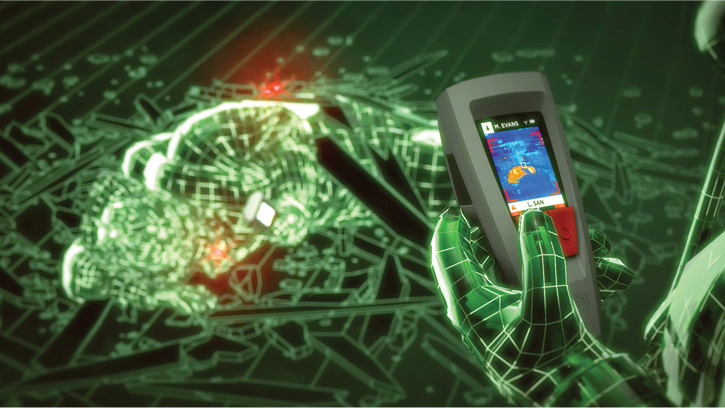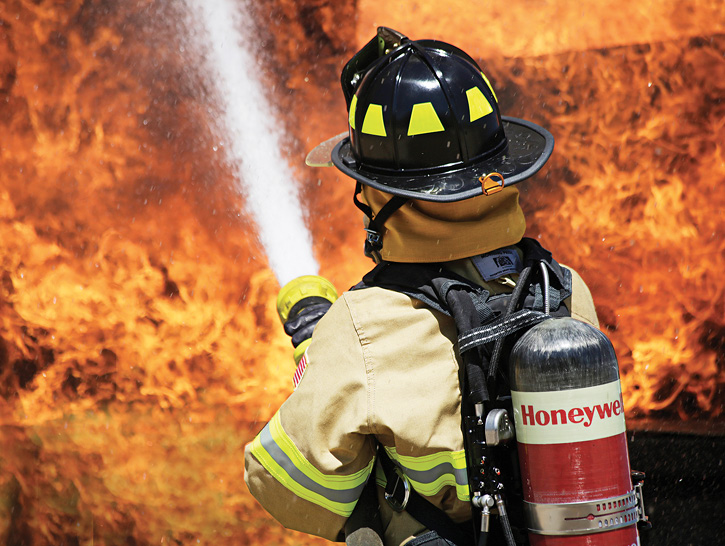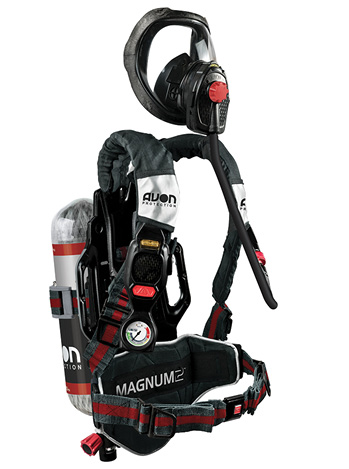
Technological advances built into self-contained breathing apparatus (SCBA) are allowing for improved firefighter situational awareness and furnishing firefighters with more information about their equipment and their surroundings. SCBA manufacturers discuss the technology they have been using to improve their SCBA.
MSA SAFETY INC.
Jason Traynor, general manager of global respiratory protection and fire helmets for MSA, notes that because of the unpredictable, hazardous nature of firefighting, it’s important for firefighters to be connected as a team, which is why MSA introduced LUNAR, a small, wireless, cloud-ready device designed to provide firefighters with enhanced vision, improved situational awareness, and team connectivity.
Traynor says that LUNAR can be used as part of MSA’s G1 SCBA system or as a stand-alone device. “LUNAR’s proprietary technology keeps firefighters connected in a broad range of ways,” he says, “including person-to-person ranging, which enables firefighters to find each other using distance and direction data, even when one may be incapacitated; GPS location, which provides safety officers and incident commanders (ICs) a bird’s-eye view of all LUNAR devices on a scene; personal thermal imaging, which is visible through a 3½-inch high-resolution display; and a motion-detected, person-down alarm, which provides an added value for those responding to fire calls where an SCBA is not deployed.”

1 MSA’s proprietary LUNAR system is a small, wireless, cloud-ready device that can be used as a stand-alone unit or as part of MSA’s G1 SCBA. This image shows the system’s thermal imaging ability. (Photos 1-2 courtesy of MSA.)

2 The MSA LUNAR system includes person-to-person ranging, which can be used by firefighters to find each other using distance and direction data and even locate a down firefighter.
Traynor points out, “Accounting for all firefighters on a fireground has been a consistent need expressed by the fire service, but it’s also been a challenge for many manufacturers to solve. When we looked at what we could do to enhance firefighter safety, we listened to feedback from thousands of firefighters, then took those insights and used a holistic approach to build a connected ecosystem of products where the sum of the individual components is the key to keeping firefighters better connected—and safer—than ever before.”
Other technology products that make up MSA’s Connected Firefighter platform, according to Traynor, are the G1 SCBA; the MSA Hub, a small, modular device that enables on-scene data and asset management; and the MSA Cloud Platform, which gives ICs the ability to evaluate and manage multiple situations at one time from any location.
3M SCOTT FIRE & SAFETY
John Dinning, global business manager of firefighter solutions for 3M Scott Fire & Safety, believes there are three elements driving technological advances in SCBA: regulatory standards, customer needs, and 3M Scott’s own research and development. “There are two standards concerning SCBA,” he says, “the [National Institute for Occupational Safety and Health (NIOSH)] Guide to the Selection and Use of Particulate Respirators and [National Fire Protection Association (NFPA)] 1852, Standard on Selection, Care, and Maintenance of Open-Circuit Self-Contained Breathing Apparatus (SCBA).” Customer needs are self-explanatory, Dinning adds, while 3M Scott’s R&D continues to design, build, test, and develop products of value to the fire service.
“Our Scott Sight hands-free thermal imager has gone into its third issue of firmware,” Dinning points out, “which runs the hardware that is an in-mask display (IMD) component with a viewing lens on the right side of the mask adjacent to the nose cup. It’s outside the normal field of view and is dimmable if the firefighter doesn’t want to show the image while the unit is on. With the lens inside the face piece, it stays clean, while a sensor on the outside transmits to the IMD via Bluetooth.” He adds that a new feature option is the Pro package, which allows video recording as well as hot and cold spot tracking, available with 3M Scott’s X series SAR cameras.

3 3M Scott Fire & Safety offers Scott Sight on its SCBA, a hands-free thermal imaging system that has hardware outside the mask and an in-mask display adjacent to the mask’s nose cup. (Photos 3-4 courtesy of 3M Scott Fire & Safety.)

4 3M Scott’s ePAR telemetry feature on its SCBA is able to send air and alarm data back to an IC on a real-time basis and also generates a PAR that is transmitted through a wireless mesh network.
“Telemetry is another technological development in our SCBA,” Dinning says. “Our ePAR feature is able to send air and alarm data back to an IC on a real-time basis. The ePAR feature also generates a personnel accountability report (PAR) that allows PAR checks to be accomplished without using a portable radio.” Dinning says that 3M Scott developed “a patented wireless mesh network that transmits between each SCBA and an antenna at the IC’s laptop to accomplish and acknowledge PAR checks. It’s a transmitter/receiver (transceiver) in the air pack that sends signals back to the IC using Scott Connect Monitor Pro software that can hop from SCBA to SCBA 10 times, greatly extending the range of the system. We also have repeater boxes for multistory buildings.”
The ability to communicate clearly is another technology that 3M Scott has improved on, Dinning says. “We work closely with all the radio manufacturers who offer Bluetooth in their portable radios to ensure our on-mask and in-mask communications connect well and allow easy transmission of voice and data while minimizing exterior noise,” he points out. “We offer the EPIC 3 radio direct interface (RDI), a modular accessory that can be clipped on and off a face piece with a quarter turn. The Bluetooth is paired to the radios, and a voice amplifier makes the face piece voice louder, taking the voice from inside the nose cup and transmitting it over the radio. You don’t have to put a lapel microphone up to the face piece.”
HONEYWELL FIRST RESPONDER PRODUCTS
Lynn Feiner, product marketing manager for Honeywell First Responder Products, says that in Honeywell’s TITAN SCBA, the heads-up display (HUD) in the face piece gives a firefighter information about the amount of air in the bottle and the life of the battery. “The HUD information is located below the line of sight so it’s not a distraction to the firefighter,” Feiner points out. “Four green lights indicate a full tank, three green show a quarter tank used, a yellow light indicates 50 percent air remaining, and a red flashing light comes on at one third air left, along with a bell or a whistle. A yellow light off to the side comes on if the SCBA’s battery is low.”
The TITAN runs Honeywell’s Safety Suite telemetry software system that communicates through RAElink 3 with an IC. “The telemetry allows the SCBA to talk with the IC within a one-mile range, altering the IC if there is a problem with the SCBA,” she says. “Also, the telemetry sends out active PAR checks, instead of having the IC ask for them. If the system is on manual, the firefighter receives audio and visual PAR check signals and double clicks to respond. If it’s on automatic, the IC is only alerted if someone fails a PAR check.” The system also is able to send out evacuation notices with audible and visual signals to each SCBA on the PASS alarm.”
Honeywell also is using radio frequency identification (RFID) tags on SCBA that link SCBA to specific firefighters. “The firefighter touches his badge to the RFID and links to it and can also link up with other firefighters as part of a team,” Feiner notes. “The system supports up to 50 active SCBA at one time, and if a firefighter needs to change an SCBA, he can relink to another unit.”
5 Honeywell First Responder Products makes the TITAN SCBA that has a HUD in the face piece that shows information through a series of LED lights about the amount of air in the air cylinder and the life of the battery. (Photos 5-6 courtesy of Honeywell First Responder Products.)

6 Honeywell’s TITAN SCBA runs the company’s Safety Suite telemetry software system that communicates through RAElink 3 with an IC to send out active PAR checks, communicate any problems with the SCBA, and receive any evacuation notices from command.
Pathfinder™ is Honeywell’s sonic beacon firefighter locating system. “We have two beacons on the back of our SCBA that, when activated, send out alarms through the radio,” Feiner says. “Pathfinder is like a hand scanner where, as you get closer to the down firefighter, the audio signal gets stronger and more rapid. It also gives the searcher a visual warning and sends him through the closest open pathway. There’s also the ability to drop breadcrumb beacons to allow them to find their way back out easier and faster.”
Honeywell’s ThermAlert™ is located on the back of the PASS alarm and uses an algorithm to calculate the temperature and the length of time a firefighter is in the building to determine when he should back off. “When it hits critical mass, it sends an alarm and stops alarming when the firefighter is out of the high heat danger position,” she says. Honeywell continues to work on the issue of real-time firefighter location for ICs, Feiner adds. “We are actively working on making it lightweight, three dimensional, and affordable,” she says. “It’s still in the R&D stage, but the direction we are going in the hardware would be on the SCBA, and the software would be on Safety Suite. 3D firefighter location is the holy grail of SCBA technology.”
AVON PROTECTION SYSTEMS
Darren Wolfe, global product manager for supplied air and thermal imaging at Avon Protection Systems, says that the in-mask Bluetooth microchip and microphone on Avon Protection’s Magnum 2 SCBA “offers very good speech communications and noise canceling, with the audio only amplified when the user is actually speaking so you don’t get any Darth Vader style sounds.”
Avon Protection’s HUD shows lights indicating air cylinder pressure, Wolfe points out, “with two green lights for pressure from 100 to 76 percent; one green light for pressure of 75 to 51 percent; one amber light for 50 to 35 percent air remaining; and a blinking red light for 35 percent to one percent air. Our system is easy to decipher because we don’t show all the lights at once, only the actual value of the air remaining.”

7 Avon Protection Systems makes the Magnum 2 SCBA with an in-mask Bluetooth noise-canceling microchip that only amplifies audio when the user is actually speaking. (Photos 7-8 courtesy of Avon Protection Systems.)

8 The Magnum 2 SCBA has two buddy lights on the back and one on each side, and their color coincides with the pressure level of the air cylinder as seen in the in-mask HUD.
Wolfe notes that Avon Protection has two buddy lights on the back of the Magnum 2, one on each side, and their colors coincide with the pressure level of the air cylinder as seen in the HUD. “It allows situational awareness for nearby firefighters,” he says, “and we added light piping to deflect the light outward more. On the SCBA, we also removed some textiles and added nonskid materials that are easier to decontaminate.”
ALAN M. PETRILLO is a Tucson, Arizona-based journalist, the author of three novels and five nonfiction books, and a member of the Fire Apparatus & Emergency Equipment Editorial Advisory Board. He served 22 years with the Verdoy (NY) Fire Department, including in the position of chief.

